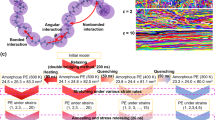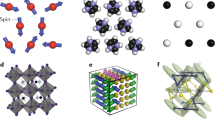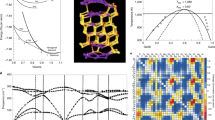Abstract
The elastic modulus and coefficient of thermal expansion are fundamental properties of elastically stiff molecular materials and are assumed to be the same (symmetric) under both tension and compression loading. We show that molecular materials can have a marked asymmetric elastic modulus and coefficient of thermal expansion that are inherently related to terminal chemical groups that limit molecular network connectivity. In compression, terminal groups sterically interact to stiffen the network, whereas in tension they interact less and disconnect the network. The existence of asymmetric elastic and thermal expansion behaviour has fundamental implications for computational approaches to molecular materials modelling and practical implications on the thermomechanical strains and associated elastic stresses. We develop a design space to control the degree of elastic asymmetry in molecular materials, a vital step towards understanding their integration into device technologies.
This is a preview of subscription content, access via your institution
Access options
Subscribe to this journal
Receive 12 print issues and online access
$259.00 per year
only $21.58 per issue
Buy this article
- Purchase on Springer Link
- Instant access to full article PDF
Prices may be subject to local taxes which are calculated during checkout





Similar content being viewed by others
References
de Lima, J. J., Lacerda, R. G., Vilcarromero, J. & Marques, F. C. Coefficient of thermal expansion and elastic modulus of thin films. J. Appl. Phys. 86, 4936–4942 (1999).
Rosenfield, A. R. & Averbach, B. L. Effect of stress on the expansion coefficient. J. Appl. Phys. 27, 154–156 (1956).
Preston, S. D. & Marsden, B. J. Changes in the coefficient of thermal expansion in stressed Gilsocarbon graphite. Carbon NY 44, 1250–1257 (2006).
Jones, R. M. Stress-strain relations for materials with different moduli in tension and compression. AIAA J. 15, 16–23 (1977).
Cai, K. Effects of the properties of bi-modulus material on stiffness design. 2010 Int. Conf. Intell. Comput. Technol. Autom. (ICICTA), 11 May 2010, Vol. 2, 192–195 (IEEE, 2010).
Medri, G. A nonlinear elastic model for isotropic materials with different behavior in tension and compression. J. Eng. Mater. Technol. 104, 26–28 (1982).
Destrade, M., Murphy, J. G. & Rashid, B. Differences in tension and compression in the nonlinearly elastic bending of beams. Preprint at http://arxiv.org/abs/1303.1901 (2013).
Volksen, W., Miller, R. D. & Dubois, G. Low dielectric constant materials. Chem. Rev. 110, 56–110 (2009).
Yoldas, B. E. Investigations of porous oxides as an antireflective coating for glass surfaces. Appl. Opt. 19, 1425–1429 (1980).
Chen, X., Xiang, Y. & Vlassak, J. J. Novel technique for measuring the mechanical properties of porous materials by nanoindentation. J. Mater. Res. 21, 715–724 (2006).
Fischer-Cripps, A. C. Nanoindentation (Springer, 2004).
Volinsky, A. A., Vella, J. B. & Gerberich, W. W. Fracture toughness, adhesion and mechanical properties of low-k dielectric thin films measured by nanoindentation. Thin Solid Films 429, 201–210 (2003).
Takimura, T., Hata, N., Takada, S. & Yoshino, T. Determination of mechanical properties of porous silica low-k films on Si substrates using orientation dependence of surface acoustic wave. Jpn. J. Appl. Phys. 47, 5400–5403 (2008).
Kirkpatrick, S., Gelatt, C. D. & Vecchi, M. P. Optimization by simulated annealing. Science 220, 671–680 (1983).
Plimpton, S. Fast parallel algorithms for short-range molecular-dynamics. J. Comput. Phys. 117, 1–19 (1995).
Dubois, G. et al. Molecular network reinforcement of sol–gel glasses. Adv. Mater. 19, 3989–3994 (2007).
Tajima, N. et al. Molecular modeling of low-k films of carbon-doped silicon oxides for theoretical investigations of the mechanical and dielectric properties. Appl. Phys. Lett. 89, 061907 (2006).
Tajima, N. et al. Carbon-doped silicon oxide films with hydrocarbon network bonds for low-k dielectrics: theoretical investigations. Jpn. J. Appl. Phys. 46, 5970–5974 (2007).
Oliver, M. S., Dubois, G., Sherwood, M., Gage, D. M. & Dauskardt, R. H. Molecular origins of the mechanical behavior of hybrid glasses. Adv. Funct. Mater. 20, 2884–2892 (2010).
Humphrey, W., Dalke, A. & Schulten, K. VMD: visual molecular dynamics. J. Mol. Graph. 14, 33–38 (1996).
Liu, B. & Qiu, X. M. How to compute the atomic stress objectively? J. Comput. Theor. Nanosci. 6, 1081–1089 (2009).
Subramaniyan, A. K. & Sun, C. T. Continuum interpretation of virial stress in molecular simulations. Int. J. Solids Struct. 45, 4340–4346 (2008).
Finney, J. L. A procedure for the construction of Voronoi polyhedra. J. Comput. Phys. 32, 137–143 (1979).
Tanemura, M., Ogawa, T. & Ogita, N. A new algorithm for three-dimensional Voronoi tessellation. J. Comput. Phys. 51, 191–207 (1983).
Gellatly, B. J. & Finney, J. L. Characterisation of models of multicomponent amorphous metals: the radical alternative to the Voronoi polyhedron. J. Non-Cryst. Solids 50, 313–329 (1982).
Sietsma, J. & Thijsse, B. J. Characterization of free volume in atomic models of metallic glasses. Phys. Rev. B 52, 3248–3255 (1995).
Arizzi, S., Mott, P. H. & Suter, U. W. Space available to small diffusants in polymeric glasses: analysis of unoccupied space and its connectivity. J. Polym. Sci. B 30, 415–426 (1992).
Voloshin, V. P., Medvedev, N. N. & Geiger, A. Fast Calculation of the Empty Volume in Molecular Systems by the Use of Voronoi-Delaunay Subsimplexes 156–172 (Trans. Comput. Sci. XXII, Springer, 2014).
Voloshin, V. P. & Naberukhin, Y. I. Empty interatomic space in computer models of simple liquids and amorphous solids. J. Phys. Condens. Matter 5, 5685–5700 (1993).
Cameron, K. K. & Dauskardt, R. H. Fatigue damage in bulk metallic glass I: simulation. Scr. Mater. 54, 349–353 (2006).
Rycroft, C. Voro++: A Three-Dimensional Voronoi Cell Library in C++ (Lawrence Berkeley National Laboratory, 2009).
Chu, J. J. & Steeves, C. A. Thermal expansion and recrystallization of amorphous Al and Ti: a molecular dynamics study. J. Non-Cryst. Solids 357, 3765–3773 (2011).
Liu, Z. K., Wang, Y. & Shang, S. L. Thermal expansion anomaly regulated by entropy. Sci. Rep. 4, 7043 (2014).
Grandbois, M., Beyer, M., Rief, M., Clausen-Schaumann, H. & Gaub, H. E. How strong is a covalent bond? Science 283, 1727–1730 (1999).
Bhattacharya, S. & Kieffer, J. Fractal dimensions of silica gels generated using reactive molecular dynamics simulations. J. Chem. Phys. 122, 094715 (2005).
Rao, N. Z. & Gelb, L. D. Molecular dynamics simulations of the polymerization of aqueous silicic acid and analysis of the effects of concentration on silica polymorph distributions, growth mechanisms, and reaction kinetics. J. Phys. Chem. B 108, 12418–12428 (2004).
Sefcik, J. & Rankin, S. E. Monte Carlo simulations of size and structure of gel precursors in silica polycondensation. J. Phys. Chem. B 107, 52–60 (2003).
Striolo, A., McCabe, C. & Cummings, P. T. Thermodynamic and transport properties of polyhedral oligomeric sislesquioxanes in poly(dimethylsiloxane). J. Phys. Chem. B 109, 14300–14307 (2005).
Striolo, A., McCabe, C. & Cummings, P. T. Organic–inorganic telechelic molecules: solution properties from simulations. J. Chem. Phys. 125, 104904 (2006).
Feuston, B. P. & Garofalini, S. H. Empirical three-body potential for vitreous silica. J. Chem. Phys. 89, 5818–5824 (1988).
Jorgensen, W. L., Maxwell, D. S. & Rives, J. T. Development and testing of the OPLS all-atom force field on conformational energetics and properties of organic liquids. J. Am. Chem. Soc. 118, 11225–11236 (1996).
Stillinger, F. H. & Weber, T. A. Computer simulation of local order in condensed phases of silicon. Phys. Rev. B 31, 5262–5271 (1985).
Oliver, M., Dubois, G. & Dauskardt, R. H. Molecular design of ultra-low-k hybrid glasses. 2010 IEEE Int. Interconnect Technol. Conf. (IITC), 6 June 2010, 1–3 (IEEE, 2010).
Oliver, M., Dubois, G., Sherwood, M., Gage, D. M. & Dauskardt, R. H. Mechanical fatigue of hybrid glasses. Small 6, 1892–1896 (2010).
Rimsza, J. M., Deng, L. & Du, J. Molecular dynamics simulations of nanoporous organosilicate glasses using Reactive Force Field (ReaxFF). J. Non-Cryst. Solids 431, 103–111 (2015).
Barber, C. B., Dobkin, D. P. & Huhdanpaa, H. The Quickhull algorithm for convex hulls. ACM Trans. Math. Softw. 22, 469–483 (1996).
Graham, R. L. An efficient algorithm for determining the convex hull of a finite planar set. Inf. Process. Lett. 1, 132–133 (1972).
Lee, D.-T. & Schachter, B. J. Two algorithms for constructing a Delaunay triangulation. Int. J. Comput. Inf. Sci. 9, 219–242 (1980).
Acknowledgements
We thank the US Department of Energy, Office of Basic Energy Sciences, for their financial support under Contract No. DE-FG02-07ER46391.
Author information
Authors and Affiliations
Contributions
J.A.B. designed and performed simulations, analysed data, and wrote the manuscript. R.H.D. wrote the manuscript and supervised the research.
Corresponding author
Ethics declarations
Competing interests
The authors declare no competing financial interests.
Supplementary information
Supplementary Information
Supplementary Information (PDF 5681 kb)
Rights and permissions
About this article
Cite this article
Burg, J., Dauskardt, R. Elastic and thermal expansion asymmetry in dense molecular materials. Nature Mater 15, 974–980 (2016). https://doi.org/10.1038/nmat4674
Received:
Accepted:
Published:
Issue Date:
DOI: https://doi.org/10.1038/nmat4674
This article is cited by
-
Computational prediction of the molecular configuration of three-dimensional network polymers
Nature Materials (2021)
-
Giant thermal expansion of a two-dimensional supramolecular network triggered by alkyl chain motion
Communications Materials (2020)
-
Extravascular gelation shrinkage-derived internal stress enables tumor starvation therapy with suppressed metastasis and recurrence
Nature Communications (2019)
-
Hyperconnected molecular glass network architectures with exceptional elastic properties
Nature Communications (2017)



